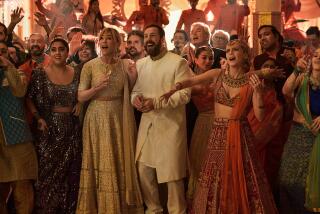Where have all the women gone in movies?
- Share via
There’s one mountain in Hollywood that even “The Hunger Games’” scrappy heroine Katniss Everdeen hasn’t been able to move: the number of roles for women.
Despite the success of recent female-driven movies such as “Bridesmaids” and the “Hunger Games” and “Twilight” series, female representation in popular movies is at its lowest level in five years, according to a study being released Monday by the USC Annenberg School for Communication and Journalism.
Among the 100 highest-grossing movies at the U.S. box office in 2012, the study reported, 28.4% of speaking characters were female. That’s a drop from 32.8% three years ago, and a number that has stayed relatively stagnant despite increased research attention to the topic and several high-profile box-office successes starring women.
PHOTOS: All-time box-office leaders
“There is notable consistency in the number of females on-screen from year to year,” said USC researcher Marc Choueiti. “The slate of films developed and produced each year is almost formulaic — in the aggregate, female representation hardly changed at all.”
When they are on-screen, 31.6% of women are shown wearing sexually revealing clothing, the highest percentage in the five years the USC researchers have been studying the issue.
For teen girls, the number who are provocatively dressed is even higher: 56.6% of teen girl characters in 2012 movies wore sexy clothes, an increase of 20% since 2009.
The USC researchers said these trends persist because those working in Hollywood believe attracting a male audience is the key ingredient to box office success.
“Industry perceptions of the audience drive much of what we see on-screen,” said study author Stacy L. Smith. “There is a perception that movies that pull male sell. Given that females go to the movies as much as males, the lack of change is likely due to entrenched ways of thinking and doing business that perpetuate the status quo.”
Female characters are more prevalent — and less likely to be sexualized — in movies written and directed by women, according to Smith.
PHOTOS: The costliest box office flops
A study USC released in January in conjunction with the Sundance Institute and Women in Film Los Angeles found that women have made more inroads in those kinds of behind-the-camera jobs in independent film and documentaries than they have in big-budget studio movies.
But it’s typically the studio movies that drive the box office — and shape audiences.
“Some depictions of females on-screen can have unintended and negative consequences for viewers,” Smith said. “Every voice deserves a chance to be heard and every story a chance to be told. At the moment ... that does not seem to be the case in popular film.”
More to Read
Only good movies
Get the Indie Focus newsletter, Mark Olsen's weekly guide to the world of cinema.
You may occasionally receive promotional content from the Los Angeles Times.











